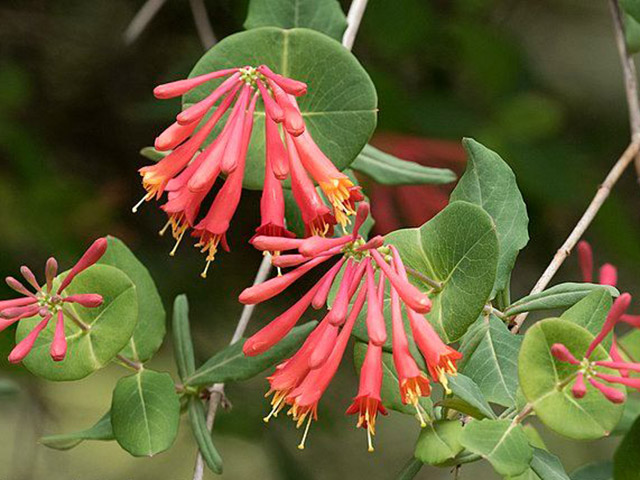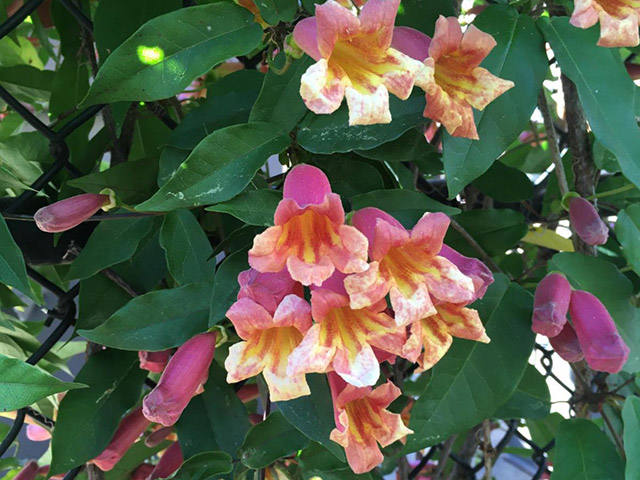Native Pollinator Vines
Recommended Vines
Did you know? Gardeners and homeowners can keep vines in check by training them onto trellises and pruning them regularly.
Below is a list of suggested vines native to North Carolina. Most of the vines listed can be found in all three major regions of North Carolina (Piedmont, coastal, mountain). This list isn’t intended to be comprehensive and only highlights a selection of vines that many nurseries and garden centers are likely to carry.
North Carolina Native Vines
Climbing Aster
Climbing aster, Ampleaster carolinianus, is an herbaceous vine that is native to southeastern North America. It can be found naturally growing on forest edges or streambanks and in moist prairies or woodlands.
Climbing aster is a sprawling vine that tends to grow over plants, up a trellis or on a fence. It can be pruned in the spring to retain a more shrubby appearance. This plant can grow six to ten feet tall in full sun or partial shade. While it can tolerate brief periods of flooding, it prefers moist, well-draining soils.
Blooming in late summer and into fall, climbing aster is an excellent resource for late flying pollinators who visit the breathtaking display of pink-purple blooms. The daisy-like flowers have yellow centers that add lots of color to a garden. Once pollinated, the seeds may be eaten by songbirds or small mammals.
Climbing aster is a versatile native appropriate for a variety of garden types. Plant it on a slope as a ground cover, train it up a trellis or incorporate into a pollinator garden, cottage garden, meadow garden or naturalized area.
Fun Fact: Historically, leaves of climbing aster were steamed and used medicinally for itchy skin.
Coral Honeysuckle
Coral honeysuckle, Lonicera sempervirens, is a woody vine that is native to southeastern North America. It can be grown in all three regions of North Carolina in woodlands and edge habitats.
This native vine typically grows in partial shade to full sun, with more blooms on plants in full sun. It is adaptable to both well-draining clay soils and moist loam soils with a fair amount of organic matter. Growing 10-20 feet tall, coral honeysuckle is a great twining and climbing vine for a trellis, fence or other structure.
Coral honeysuckle is a great wildlife and pollinator plant. Its trumpet-shaped flowers appear in early summer and grow on the terminal ends of the vine. The flowers can be red, red-orange or yellow and they typically bloom from March to July. The proliferating blooms will attract hummingbirds, bees, butterflies and the occasional moth.
The leaves are dark green and the first few leaves below the flowers are fused together. This plant is semi-evergreen and will retain some of its leaves through the winter.
Caterpillars that are spotted munching on the leaves may develop into snowberry clearwing moths or spring azure butterflies since both of these pollinators use coral honeysuckle as a host plant. Red berries develop in the late summer and are attractive to birds.
Coral honeysuckle can be grown as a ground cover or up a trellis, making a great addition to butterfly gardens, native plant gardens, or pollinator gardens.
Fun Fact: Juice from the plant's leaves were historically used to treat bee stings.
Crossvine
Crossvine, Bignonia capreolata, is a woody perennial vine that is native to the southeastern United States. Naturally found in swamps or woodlands, this twining vine is tough and can be planted in a variety of conditions making it an excellent choice for gardeners. Although crossvine is tolerant of full shade, it will produce more flowers when planted in full sun. It's semi-evergreen nature will make this plant an excellent addition to your garden since it will retain most of its leaves during the winter months.
This spring bloomer is an early nectar source for pollinators and will attract some of the first hummingbirds of the new year to your yard. Not only do the trumpet-shaped flowers provide tasty nectar but its leaves are also a food source for several types of sphinx moth larvae.
Fun Fact: The inner pith of the woody section of the vine resembles a cross, giving this vine its nickname!
Passionflower
Passionflower, Passiflora incarnata, is a deciduous vine that is native to the central and southeastern regions of North America. It can be found growing along woodland edges, meadows, fields, old pastures and other similar habitats.
Passionflower is a woody, twining vine that will spread and climb along fences, trellises or other support structures. It will grow in full sun or partial shade and prefers moist, well-draining soils. It can be grown in all three regions of North Carolina.
In summer and into early fall, passion flower produces several head inflorescences that consist of white to purple petals with a central crown of frilly pink-purple filaments. These odd flowers will attract several pollinators including bees, butterflies and hummingbirds.
Once pollinated, it produces an edible fruit that is eaten by songbirds and other wildlife. It's green leaves support 5 lepidopteran species (moths and butterflies) including the gulf fritillary and variegated fritillary.
Passionflower can be added to an edible garden, native plant garden, wildlife garden or meadow garden. It is a great native vine to train up a trellis or arbor as well.
Fun Fact: Passionflower fruits have been long used for treating ailments due to the fruit containing antioxidants, vitamins and other nutrients.
Order Your Butterfly Highway Sign
Put up a Butterfly Highway sign to show off your amazing pollinator pitstop and start the conversation in your community about helping pollinators and conserving wildlife habitat.
Get Your Native Seed Packets
One packet of native seeds provides as many as 7 different kinds of native flowering plants for monarchs and other pollinators, creating up to 25 square feet of habitat. The seed variety includes purple coneflowers, milkweed, black-eyed Susans, and more!








